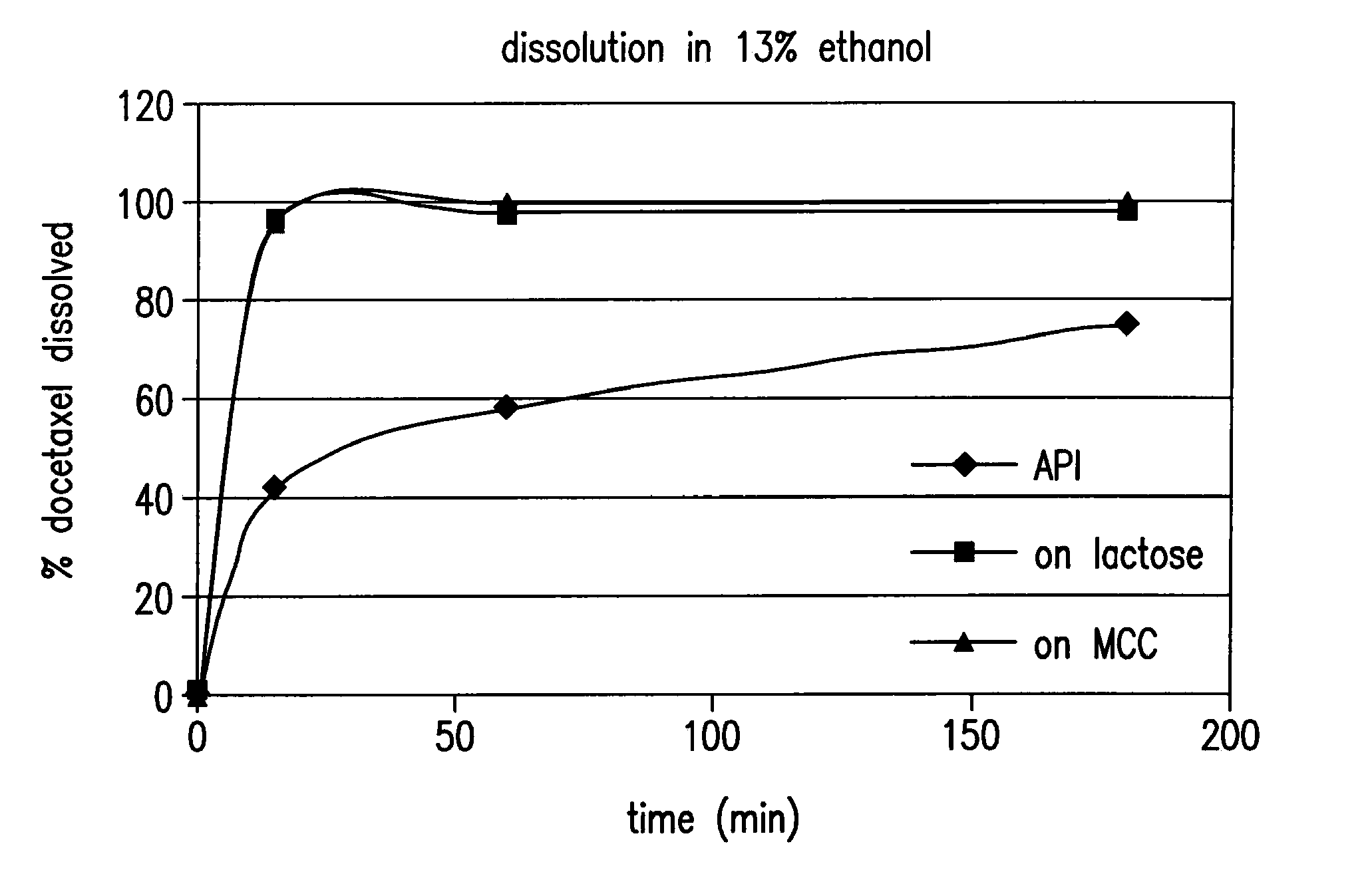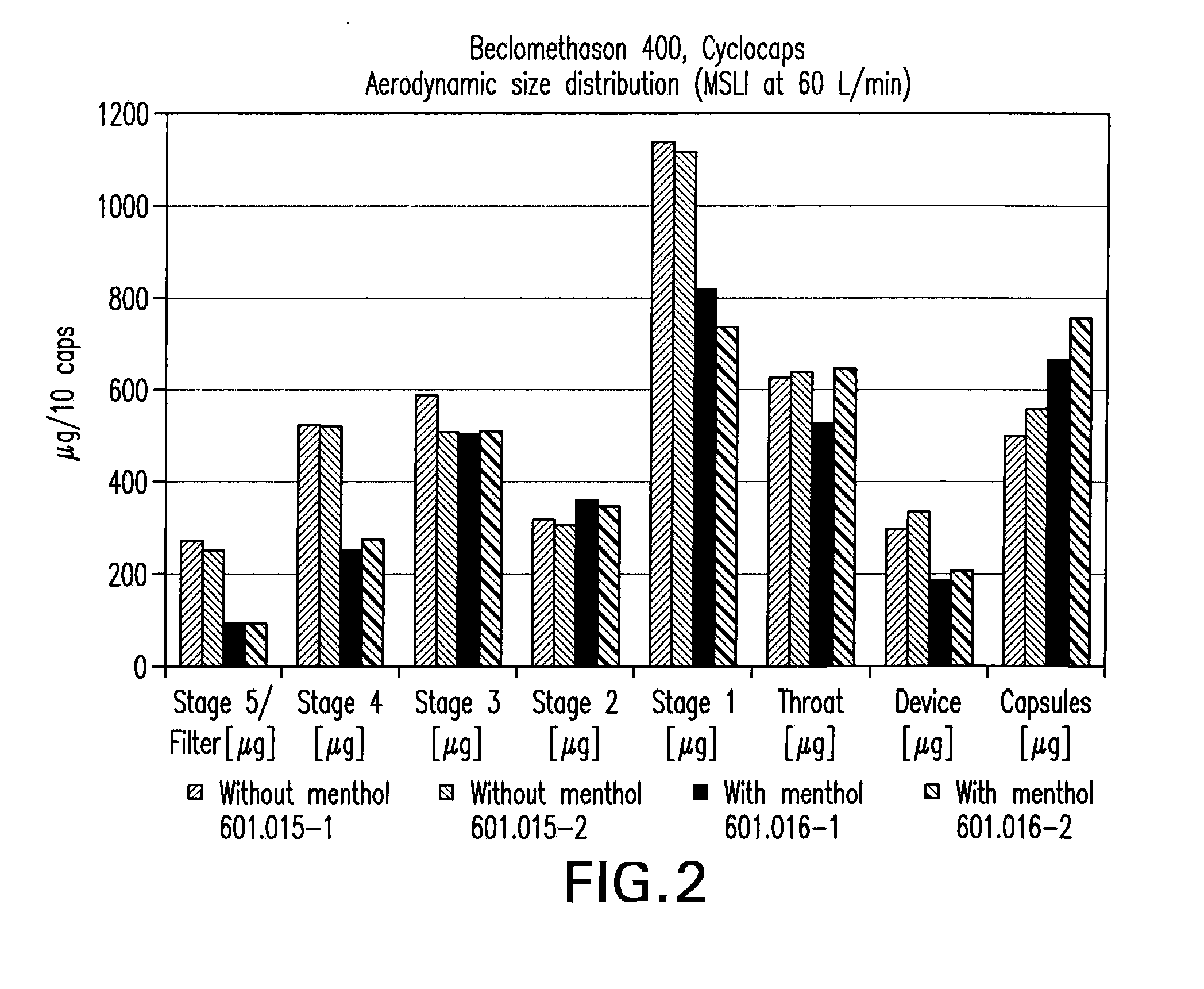Drug microparticles
- Summary
- Abstract
- Description
- Claims
- Application Information
AI Technical Summary
Benefits of technology
Problems solved by technology
Method used
Image
Examples
example 1
Solubility of Selected Drugs in Menthol
[0097] The following general procedure was repeated with several drugs with menthol carrier.
[0098] Menthol (10 grams) was melted on a stirring hot plate with magnetic stirring, then heated to the desired temperature indicated in Table 1. The desired drug was added in small increments (approximately 0.1 grams) and stirred to obtain a clear solution. The desired drug was added in increments until no more drug dissolved in the menthol. The weight of material added to the menthol melt that still gave a clear solution was taken as the solubility of the active drug at the indicated temperature. The results are given in Table 1.
TABLE 1Solubility of selected active drug substances in mentholSolubilityActive drug substancetemperature (° C.)(% w / w)Azithromycin6340.0Cyclosporin5539.2Diazepam435.7Fenofibrate6037.5Itraconazole611.0Oxybutynin609.1Risperidone708.3Salicylic acid4316.0Simvastatin6330.0
example 2
Improvement of the Dissolution of Fenofibrate by “Menthol Micronization”
[0099] Menthol (50 grams) was heated in a jacketed reactor to 60° C. After melting, the melt was stirred at 100 rpm. Fenofibrate (25 grams) was added and the mixture stirred at 100 rpm and 60° C. until full dissolution was achieved. Microcrystalline cellulose (Avicel ph 102, 55 grams) was added to the melt and the mixture was stirred for 30 minutes. The heat source was then removed and the mass allowed to cool to room temperature with the stirring continued at 100 rpm for a further 30 minutes.
[0100] The obtained mass was milled through a 6.35 mm screen in a Quadro Comil mill at 1300 rpm. The milled product was allowed to cool to 25° C. and milled again through 1.4 mm screen to obtain a powder in which the fenofibrate is dissolved in menthol and coated on the microcrystalline cellulose.
[0101] The powder was transferred to a fluid bed dryer (Aeromatic model STREA1) where the menthol was removed by drying for thr...
example 3
Improvement of the Dissolution of Oxybutynin Chloride by “Menthol Micronization”
[0103] Menthol (80 grams) was melted and oxybutynin chloride (8 grams) and microcrystalline cellulose (89.5 grams) were added and treated as in Example 2 to give a powder of micronized oxybutynin chloride on microcrystalline cellulose.
[0104] The dissolution of oxybutynin chloride from this powder (a sample of powder containing 100 mg of the active drug) was tested in a USP apparatus II dissolution tester in 100 ml of 50 mM phosphate buffer pH=6.8 at 37° C. and 50 rpm. The oxybutynin content of the dissolution sample was measured by spectrophotometer at 225 nm. The results are given in Table 3. The dissolution reached 79.2% at three hours. An equivalent simple combination of the oxybutynin chloride raw material with microcrystalline cellulose that was not treated with the menthol micronization method gave only 22.1% dissolution in three hours.
TABLE 3Dissolution of menthol treated oxybutynintime (minute...
PUM
| Property | Measurement | Unit |
|---|---|---|
| Diameter | aaaaa | aaaaa |
| Temperature | aaaaa | aaaaa |
| Temperature | aaaaa | aaaaa |
Abstract
Description
Claims
Application Information
 Login to View More
Login to View More - R&D
- Intellectual Property
- Life Sciences
- Materials
- Tech Scout
- Unparalleled Data Quality
- Higher Quality Content
- 60% Fewer Hallucinations
Browse by: Latest US Patents, China's latest patents, Technical Efficacy Thesaurus, Application Domain, Technology Topic, Popular Technical Reports.
© 2025 PatSnap. All rights reserved.Legal|Privacy policy|Modern Slavery Act Transparency Statement|Sitemap|About US| Contact US: help@patsnap.com



